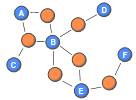Projecting two-mode networks onto weighted one-mode networks
May 1, 2009 at 12:00 am 5 comments
 This post highlights a number of methods for projecting both binary and weighted two-mode networks (also known as affiliation or bipartite networks) onto weighted one-mode networks. Although I would prefer to analyse two-mode networks in their original form, few methods exist for that purpose. These networks can be transformed into one-mode networks by projecting them (i.e., selecting one set of nodes, and linking two nodes if they are connected to the same node of the other set). Traditionally, ties in the one-mode networks are without weights. By carefully considering multiple ways of projecting two-mode networks onto weighted one-mode networks, we can maintain some of the richness contained within the two-mode structure. This enables researchers to conduct a deeper analysis than if the two-mode structure was completely ignored.
This post highlights a number of methods for projecting both binary and weighted two-mode networks (also known as affiliation or bipartite networks) onto weighted one-mode networks. Although I would prefer to analyse two-mode networks in their original form, few methods exist for that purpose. These networks can be transformed into one-mode networks by projecting them (i.e., selecting one set of nodes, and linking two nodes if they are connected to the same node of the other set). Traditionally, ties in the one-mode networks are without weights. By carefully considering multiple ways of projecting two-mode networks onto weighted one-mode networks, we can maintain some of the richness contained within the two-mode structure. This enables researchers to conduct a deeper analysis than if the two-mode structure was completely ignored.
Entry filed under: Network thoughts. Tags: actors, affiliation networks, arcs, bipartite networks, complex networks, edges, global, graphs, Links, network, nodes, social network analysis, strength of nodes, strength of ties, ties, two-mode networks, undirected networks, valued networks, vertices, weighted networks.
 RSS feed
RSS feed
1. Matthieu Latapy | December 26, 2009 at 9:53 am
Matthieu Latapy | December 26, 2009 at 9:53 am
Nice post! You may also have a look at my paper in Social Networks in which I argue that bipartite/affiliation/2-mode networks should not be projected but studied directly as such. Indeed, projection raises several issues, including loss of information and inflation of the number of links.
See the paper:
Basic Notions for the Analysis of Large Two-mode Networks.
Matthieu Latapy, Clémence Magnien and Nathalie Del Vecchio
Social Networks (2008), vol. 30, no1, pp. 31-48.
2. Tore Opsahl | December 26, 2009 at 1:49 pm
Tore Opsahl | December 26, 2009 at 1:49 pm
Thank you!
Trying to coerce networks into being static, one-mode, undirected, and binary is in fact one of the largest problems we have when analysing networks. My thesis was devoted to weighted network, whereas I’m recently dealing with two-mode networks. In particular, I have worked on a paper on clustering coefficient for two-mode networks. The global version is on this blog, and the local version will be put up January. Together they will hopefully make a paper on clustering in two-mode networks. The local coefficient that I propose is slightly different from the Jaccard coefficient you suggested in the paper.
3. Jorge Coarasa | April 6, 2010 at 3:07 pm
Jorge Coarasa | April 6, 2010 at 3:07 pm
Hi,
I am taking an introductory complex networks class and for my course projest I am trying to analyze the labor market as a network. From employment surveys, I have created a bi-partite network that links type of training to type of education. I found your post very useful and I wanted to ask you what software/language you are using to project two-mode networks into one-mode. I would like to project my two-mode network into the space of occupations and I understand the theory, but don’t know how to implement it.
Thanks
4. Tore Opsahl | April 6, 2010 at 6:45 pm
Tore Opsahl | April 6, 2010 at 6:45 pm
Hi Jorge,
If you create a two-mode edgelist with numbers and loaded it in R, then you would use tnet’s function projecting_tm to create the one-mode network. Just send me an email with the specific details of your network if you are still struggling.
Best,
Tore
5. Social Technology | August 2, 2010 at 9:06 pm
Good and Bad Social Technology… I found your entry interesting thus I’ve added a Trackback to it on my weblog :)…